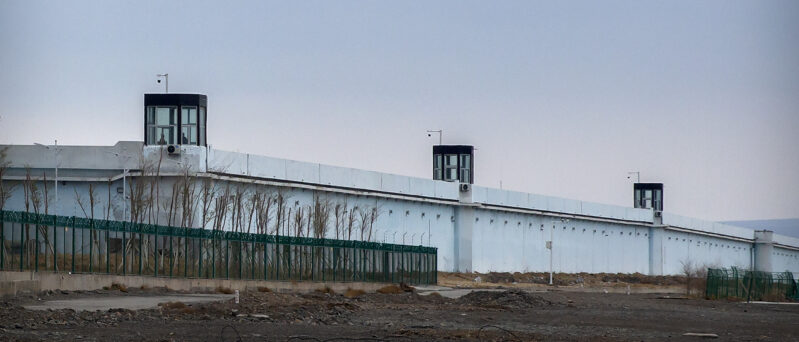An AP all-formats team gets unprecedented Western media access to China's Urumqi detention center and reveals China’s move to more permanent mass incarceration of Uyghurs and other minorities within the legal system.
The Urumqi No. 3 Detention Center in Xinjiang, China, has long been a source of fascination. It is the largest such facility in China (possibly the world), sprawling across an area twice as large as Vatican City and embodying the plight of the Uyghurs and other mostly Muslim minorities. But Western news organizations have only been able to report from outside.
Until now.
The Beijing-based team of global enterprise journalist Dake Kang, photographer Mark Schiefelbein and Greater China news director Ken Moritsugu managed to get a tour of the facility, arranged by Moritsugu over the course of multiple meetings, making The Associated Press the first Western news organization to report from inside the center.

Guard towers stand atop the perimeter wall of the Urumqi No. 3 Detention Center in Dabancheng in western China's Xinjiang region, April 23, 2021. The facility is the largest of its kind in the country and possibly the world, with a complex that sprawls over 220 acres. A sign at the front identified it as a “kanshousuo,” a pre-trial detention facility. AP estimates it can hold some 10,000 people — or more.
AP Photo / Mark Schiefelbein
Kang’s piece, along with his client video and Schiefelbein’s images, created a vivid portrait of life inside the Dabancheng detention center, from numbered and tagged Uyghurs sitting ramrod straight in line to the instructions on force-feeding in the medical room.
But the team didn’t stop at giving the world a look inside the facility. Kang’s reporting revealed a disturbing new trend: China is moving from the temporary, extralegal detention of Uyghurs to more permanent incarceration in jails and pre-trial centers within the legal system. As one expert put it: “We’re moving from a police state to a mass incarceration state. Hundreds of thousands of people have disappeared from the population … it’s the criminalization of normal behavior.”
As Kang made clear in the text story, many of the people thrown into the prisons and pre-trial centers have committed no real crimes but were sentenced for such things as going abroad or attending religious gatherings. Kang did considerable research to bolster his findings from the trip, testing what Chinese officials told the AP.
The official line was that Dabancheng was never a re-education center for Uyghurs. But through satellite imagery, old photography, documents and a contract, Kang found that Dabancheng was in fact a “training center” for Uyghurs that was simply converted into a pre-trial detention center within the prison system. He also verified that although some “training centers” have indeed been closed and Uyghurs released, new prisons and detention facilities have been built, including new buildings stretching about a mile long added to Dabancheng in 2019 as seen in satellite imagery.
The story scored at the top of AP’s reader engagement for the week with a remarkably high engagement time of more than three minutes, and it drew comment from U.S. Ambassador to the United Nations Linda Thomas-Greenfield, who called China’s repression of the Uyghurs “horrific.”
For bringing the world rare insight into the detention centers where China holds Uyghurs, the team of Kang, Schiefelbein and Moritsugu wins AP‘s Best of the Week award.
Visit AP.org to request a trial subscription to AP's video, photo and text services.
For breaking news, visit apnews.com











